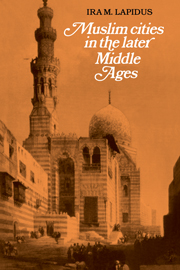Book contents
- Frontmatter
- Contents
- PREFACE
- INTRODUCTION
- CHAPTER I A HISTORY OF CITIES IN THE MAMLUK EMPIRE
- CHAPTER II THE MAMLUK REGIME IN THE LIFE OF THE CITIES
- CHAPTER III THE URBAN SOCIETY
- CHAPTER IV THE POLITICAL SYSTEM: THE MAMLUK STATE AND THE URBAN NOTABLES
- CHAPTER V THE POLITICAL SYSTEM: THE COMMON PEOPLE BETWEEN VIOLENCE AND IMPOTENCE
- CHAPTER VI CONCLUSION: SOCIETY AND POLITY IN MEDIEVAL MUSLIM CITIES
- BIBLIOGRAPHICAL NOTES
- INDEX
CHAPTER III - THE URBAN SOCIETY
Published online by Cambridge University Press: 24 November 2009
- Frontmatter
- Contents
- PREFACE
- INTRODUCTION
- CHAPTER I A HISTORY OF CITIES IN THE MAMLUK EMPIRE
- CHAPTER II THE MAMLUK REGIME IN THE LIFE OF THE CITIES
- CHAPTER III THE URBAN SOCIETY
- CHAPTER IV THE POLITICAL SYSTEM: THE MAMLUK STATE AND THE URBAN NOTABLES
- CHAPTER V THE POLITICAL SYSTEM: THE COMMON PEOPLE BETWEEN VIOLENCE AND IMPOTENCE
- CHAPTER VI CONCLUSION: SOCIETY AND POLITY IN MEDIEVAL MUSLIM CITIES
- BIBLIOGRAPHICAL NOTES
- INDEX
Summary
Mamluk influence on the cities of Egypt and Syria derived from the immense economic and political powers of the Mamluk governors and other emirs. The exercise of these powers contributed to forming the relationships between the Mamluks and the rest of the urban populations, but to understand the import of these relationships for the political organization of the cities it is essential to consider first the organization of urban community life.
Aleppo, Cairo, and Damascus were socially complex and large for premodern times. Visitors to Damascus in the late fourteenth and early fifteenth centuries commonly estimated its population to be about 100,000, and agreed that Cairo was much larger. More accurate statistics from Ottoman censuses taken a century later, between 1520 and 1530, put the population of Damascus at about 57,000, and the population of Aleppo at about 67,000 in 1520 and 57,000 a decade later. For Cairo there are no known statistics.
Ancient walls divided these cities into two major sectors, within and outside the fortifications. In addition, at Damascus there were major suburbs such as al-Sālihiyya, at a short distance from the main city, and large villages in the surrounding fruit-growing oasis called the Ghūta which impinged on the city itself and might also be considered part of a “metropolitan” conglomeration. These villages, though primarily agricultural, were not strictly peasant communities, but were sophisticated and urbane communities. Al-Mizza and Dārayyā, for example, were sites of mosques and schools.
- Type
- Chapter
- Information
- Muslim Cities in the Later Middle Ages , pp. 79 - 115Publisher: Cambridge University PressPrint publication year: 1984



